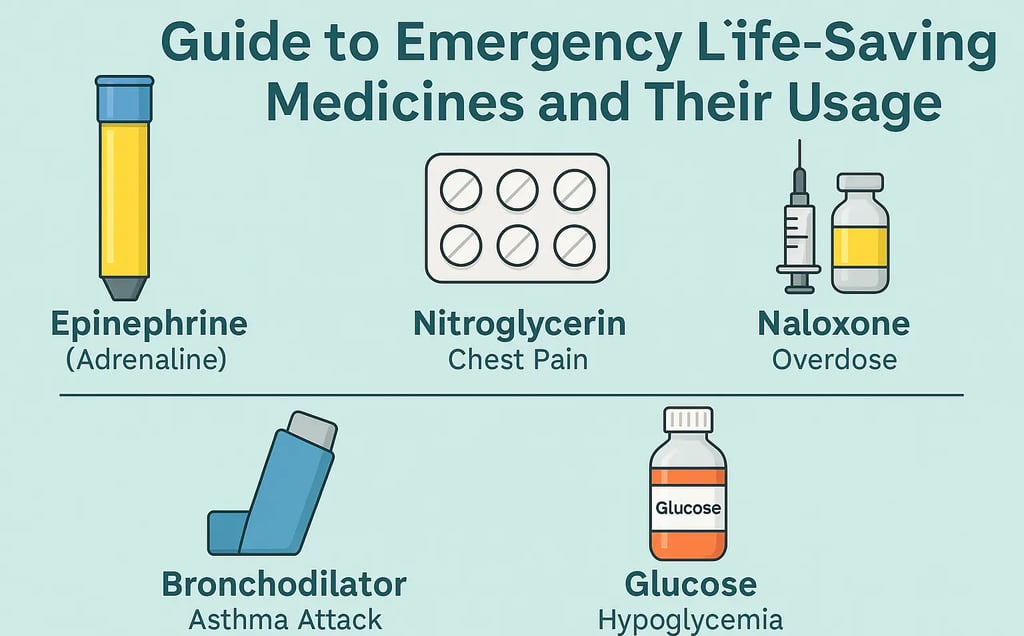Top Emergency Life-Saving Medicines: Uses, Dosages & Administration Guide
Learn about the most essential emergency life-saving medicines, including epinephrine, nitroglycerin, and naloxone. Understand how to use these emergency medications in critical situations to save lives.


🩺 Understanding Emergency Life-Saving Medicines
Emergency life-saving medicines are critical drugs used to stabilize patients during severe medical crises. Whether it's a cardiac arrest, respiratory failure, severe asthma, or a drug overdose, these medications are vital for preventing a situation from becoming fatal.
From first responders to healthcare professionals, knowing when and how to administer these drugs can significantly improve survival rates. Key medications like epinephrine, nitroglycerin, and naloxone have proven to be indispensable in saving lives during emergencies.
🚑 Why Emergency Medicines Matter
Quick access to emergency medications during health crises can mean the difference between life and death. Below are a few life-threatening conditions and the essential medicines used to treat them:
Anaphylaxis: Treated with Epinephrine (adrenaline), it rapidly reverses allergic symptoms.
Chest Pain / Angina: Nitroglycerin dilates blood vessels and improves heart blood flow.
Opioid Overdose: Naloxone immediately reverses the effects of opioids and restores breathing.
Severe Asthma Attack: Bronchodilators help open narrowed airways.
Diabetic Emergencies: Oral glucose or intravenous dextrose can stabilize blood sugar levels.
Education and awareness about the availability and administration of these drugs should be encouraged not just among medical professionals but also among caregivers and the general public.
💊 Key Emergency Medicines: Uses & Dosage
1. Epinephrine (Adrenaline)
Used For: Severe allergic reactions (anaphylaxis)
Dosage:
Adults: 0.3–0.5 mg IM
Children: 0.01 mg/kg (up to 0.3 mg)
Instructions: Use auto-injector on outer thigh. Store in a cool, dark place.
2. Nitroglycerin
Used For: Chest pain, heart attacks (angina)
Dosage: 0.3 to 0.6 mg sublingual tablet, repeat every 5 minutes (max 3 doses)
Instructions: Store in original, light-resistant container.
3. Naloxone (Narcan)
Used For: Opioid overdose reversal
Dosage: 0.4–2 mg IM or intranasally; repeat every 2–3 minutes if needed
Instructions: Monitor for withdrawal symptoms in opioid-dependent individuals.
🔒 Always check medication expiry dates and ensure proper storage to maintain effectiveness.
🧪 How to Administer Emergency Medicines
✅ Auto-Injectors (e.g., Epinephrine)
Firmly press against the outer thigh. Hold for 3–5 seconds.
Ensure full dose is delivered and seek medical help immediately.
✅ Inhalers (e.g., for Asthma)
Shake inhaler, exhale fully, then inhale while pressing the canister.
Wait 30–60 seconds before taking a second puff if needed.
✅ Oral Solutions (e.g., Glucose for Hypoglycemia)
Only for conscious patients. Administer 15–20g of glucose and monitor response.
✅ Intravenous Medications
Reserved for trained medical personnel. Requires IV insertion and monitoring.
⛑️ Basic Life Support (BLS) training is strongly recommended for non-medical individuals who wish to administer emergency medications safely.
⚖️ Legal & Ethical Considerations
✅ Good Samaritan Laws
These laws protect bystanders and caregivers who administer emergency aid in good faith from legal liability. However, laws vary by country and state—know your local regulations.
✅ Informed Consent in Emergencies
Though difficult to obtain during critical moments, informed consent (even if abbreviated) is vital when administering medications. For minors or incapacitated patients, default legal guidelines or advance directives must be followed.
✅ Ethical Dilemmas
Using emergency medicines in vulnerable populations (children, elderly, or mentally impaired) involves ethical considerations. Always prioritize safety, professional standards, and clinical guidelines to make the best decision.
📦 Final Thoughts
Being prepared for a medical emergency involves more than just having a first-aid kit—it means knowing what medications to use, when, and how. Whether you're a healthcare professional or an informed citizen, understanding emergency life-saving medicines can help save lives.
🔁 Related Posts You Might Like:
What Is Sunscreen? Benefits, Types, Ingredients & Safety Explained
Hair Loss Explained: Causes, Symptoms, and Proven Treatments
Cervical Spondylosis: Causes, Symptoms, Diagnosis, and Treatment of Neck Arthritis
